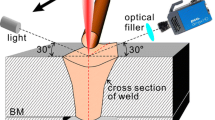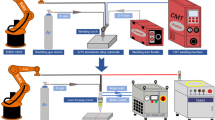Abstract
The ultrasonic welding was carried out to improve the quality of dissimilar Al/Mg alloy joint. The effects of laser texturing on the microstructure and mechanism of AZ31B/5052 joint connected by ultrasonic welding were also investigated. A series of laser texturing experiments on Al alloy (5052) and Mg alloy (AZ31B) were performed to determine the process parameters and their effect on ultrasonic weld quality, especially on weld strength. Little effect was attained by optimizing welding parameters in improving mechanical properties. Both welding parameters and different texture pattern were investigated to obtain good weld quality. The connection mechanisms of joints were discussed based on the analysis of weld interface morphology and microstructure evolution. Mechanical analysis of particle and movement of material atoms were analyzed in the study to explain the connect mechanism. The results show that the better lock-interface and lager lap shear strength were attained by laser texture addition and optimal welding parameters. Compared with the untextured joint, swirling bonding interface was obtained after the laser texture. The laser texture with grid pattern was found to raise the strength up to 26% higher maximum tensile-shear load than the joints obtained with the untextured surface.













Similar content being viewed by others
References
Suhuddin UFH, Fischer V, Kostka A, dos Santos JF (2017) Microstructure evolution in refill friction stir spot weld of a dissimilar Al–Mg alloy to Zn-coated steel. Sci Technol Weld Join 22:658–665
Nie JF, Zhu YM, Liu JZ, Fang X-Y (2013) Periodic segregation of solute atoms in fully coherent twin boundaries. Science 340(80-.):957–960
Li X, Tian H, Wang T, Zhang S (2018) Effect of ultrasonic transducer structure on friction plasticizing heating rate under the longitudinal vibration excitation. Microsyst Technol
He G, Zhao Y, Gan B, Sheng X, Liu YU, Tan L (2020) Mechanism of grain refinement in an equiatomic medium-entropy alloy CrCoNi during hot deformation. J Alloys Compd 815:152382. https://doi.org/10.1016/j.jallcom.2019.152382
Zhang S, Zhao Y, Cheng X, Chen G, Dai Q (2009) High-energy ultrasonic field effects on the microstructure and mechanical behaviors of A356 alloy. J Alloys Compd 470(1–2):168–172. https://doi.org/10.1016/j.jallcom.2008.02.091
Neppiras EA (1965) Ultrasonic welding of metals. Ultrasonics 7–10:128–135
Annoni M, Carboni M (2011) Ultrasonic metal welding of AA6022-T4 lap joints: Part I - Technological characterization and mechanical behavior. Sci Technol Weld Join 16(2):107–115
Feng M-N, Luo Z (2018) Interface morphology and microstructure of high-power ultrasonic spot welded Mg/Al dissimilar joint. Sci Technol Weld Join 24:63–78. https://doi.org/10.1080/13621718.2018.1483598
Xie J, Zhu Y, Bian F, Liu C (2017) Dynamic recovery and recrystallization mechanisms during ultrasonic spot welding of Al-Cu-Mg alloy. Mater Charact 132:145–155. https://doi.org/10.1016/j.matchar.2017.06.018
Gu X, Sui C, Liu J, Li D, Meng Z, Zhu K (2019) Microstructure and mechanical properties of Mg/Al joints welded by ultrasonic spot welding with Zn interlayer. Mater Des 181. https://doi.org/10.1016/j.matdes.2019.108103
Peng H, Jiang X, Bai X, Li D, Chen D (2018) Microstructure and mechanical properties of ultrasonic spot welded Mg/Al alloy dissimilar joints. Metals (Basel) 8:229
Pardal G, Meco S, Dunn A, Williams S, Ganguly S, Hand DP, Wlodarczyk KL (2017) Laser spot welding of laser textured steel to aluminium. J Mater Process Technol 241:24–35. https://doi.org/10.1016/j.jmatprotec.2016.10.025
Ta VD et al (2016) Laser textured surface gradients. Appl Surf Sci 371:583–589. https://doi.org/10.1016/j.apsusc.2016.03.054
Gorji NE, O’Connor R, Brabazon D (2021) XPS, SEM, AFM, and nano-indentation characterization for powder recycling within additive manufacturing process. IOP Conf Ser: Mater Sci Eng 1182(1):012025 (6pp)
Yajiang LI (2007) Special connection technology. Beijing: Machinery Industry Press, p 209–210
Won SJ, Kim HS (2019) Effects of laser parameters on morphological change and surface properties of aluminum alloy in masked laser surface texturing. J Manuf Process 48:260–269. https://doi.org/10.1016/j.jmapro.2019.10.034
Shi T, Wang C, Mi G, Yan F (2019) A study of microstructure and mechanical properties of aluminum alloy using laser cleaning. J Manuf Process 42:60–66. https://doi.org/10.1016/j.jmapro.2019.04.015
Feng Z et al (2019) Effect of laser texturing on the surface characteristics and bonding property of 30CrMnSiA steel adhesive joints. J Manuf Process 47:219–228. https://doi.org/10.1016/j.jmapro.2019.09.046
Laser cleaning process of 2219 aluminum alloy anodic oxide film before welding (2019) Chin J Lasers 46:0102005
Ilie F (2018) Diffusion and mass transfer mechanisms during frictional selective transfer. Int J Heat Mass Transf 116:1260–1265. https://doi.org/10.1016/j.ijheatmasstransfer.2017.09.083
Popov VL, Psakhie SG (2007) Numerical simulation methods in tribology. Tribol Int 40:916–923. https://doi.org/10.1016/j.triboint.2006.02.020
Funding
This work was supported by the Natural Science Foundation of Shanghai (Grant No. 20ZR1422600) and Shanghai Songjiang District Science and Technology Commission, intelligent testing of high-speed riveting process performance and new process development (Grant No.20SJKJGG7C).
Author information
Authors and Affiliations
Contributions
Methodology, validation, formal analysis, and writing—original draft preparation, C.W.; conceptualization, resources, funding acquisition, and writing—review and editing, Y.F.; investigation and data curation, J.H.; visualization, supervision, project administration, J.L. and S.Z. All the authors have read and agreed to the published version of the manuscript.
Corresponding author
Ethics declarations
Ethics approval
Not applicable.
Consent to participate
Not applicable.
Consent for publication
Not applicable.
Conflict of interest
The authors declare no competing interests.
Additional information
Publisher's Note
Springer Nature remains neutral with regard to jurisdictional claims in published maps and institutional affiliations.
This article is part of the Topical Collection: New Intelligent Manufacturing Technologies through the Integration of Industry 4.0 and Advanced Manufacturing
Rights and permissions
About this article
Cite this article
Wang, C., Xing, Y., Hu, J. et al. Investigation on mechanism of ultrasonic welding AZ31B/5052 joint with laser texturing on mental surface. Int J Adv Manuf Technol 122, 159–171 (2022). https://doi.org/10.1007/s00170-022-09203-2
Received:
Accepted:
Published:
Issue Date:
DOI: https://doi.org/10.1007/s00170-022-09203-2




